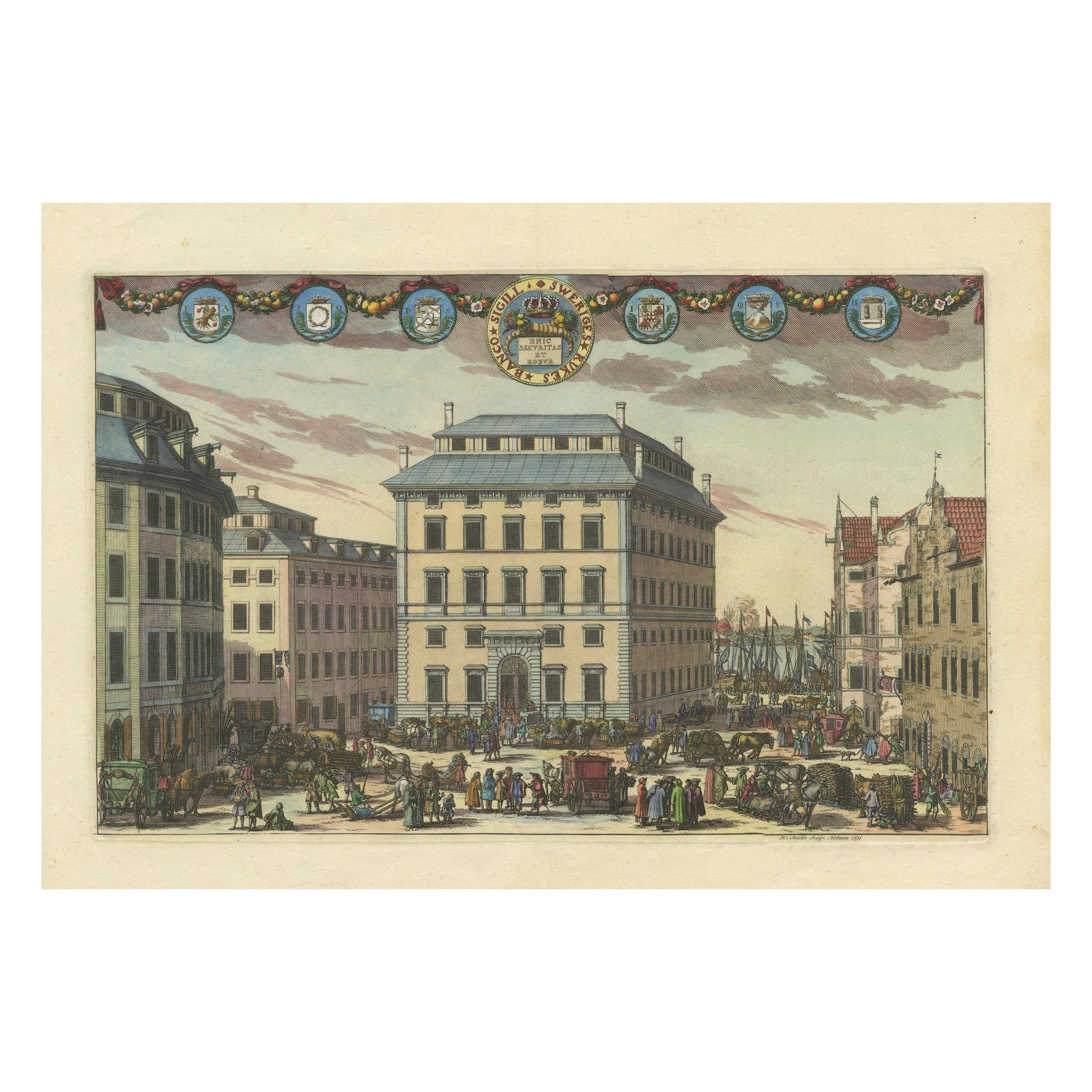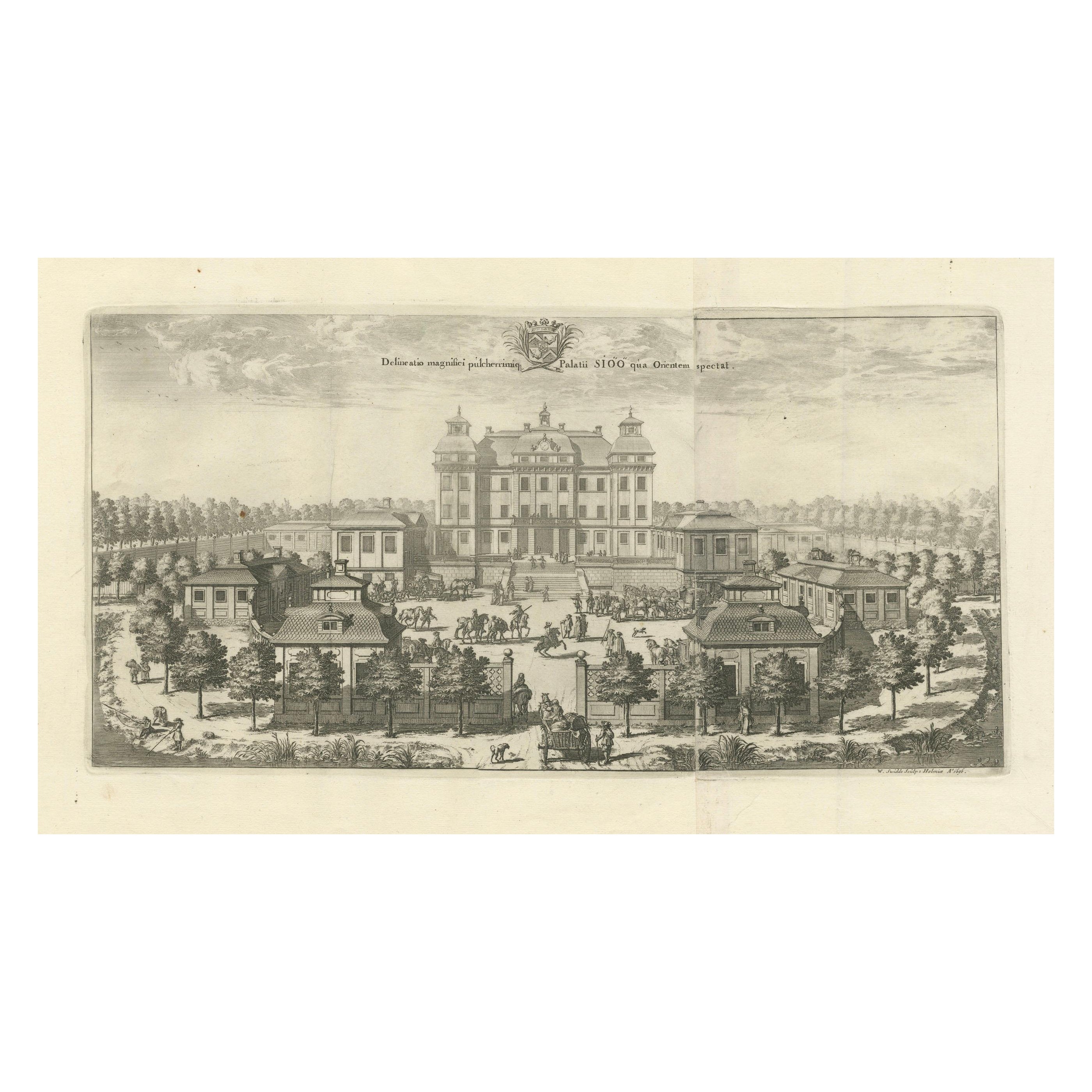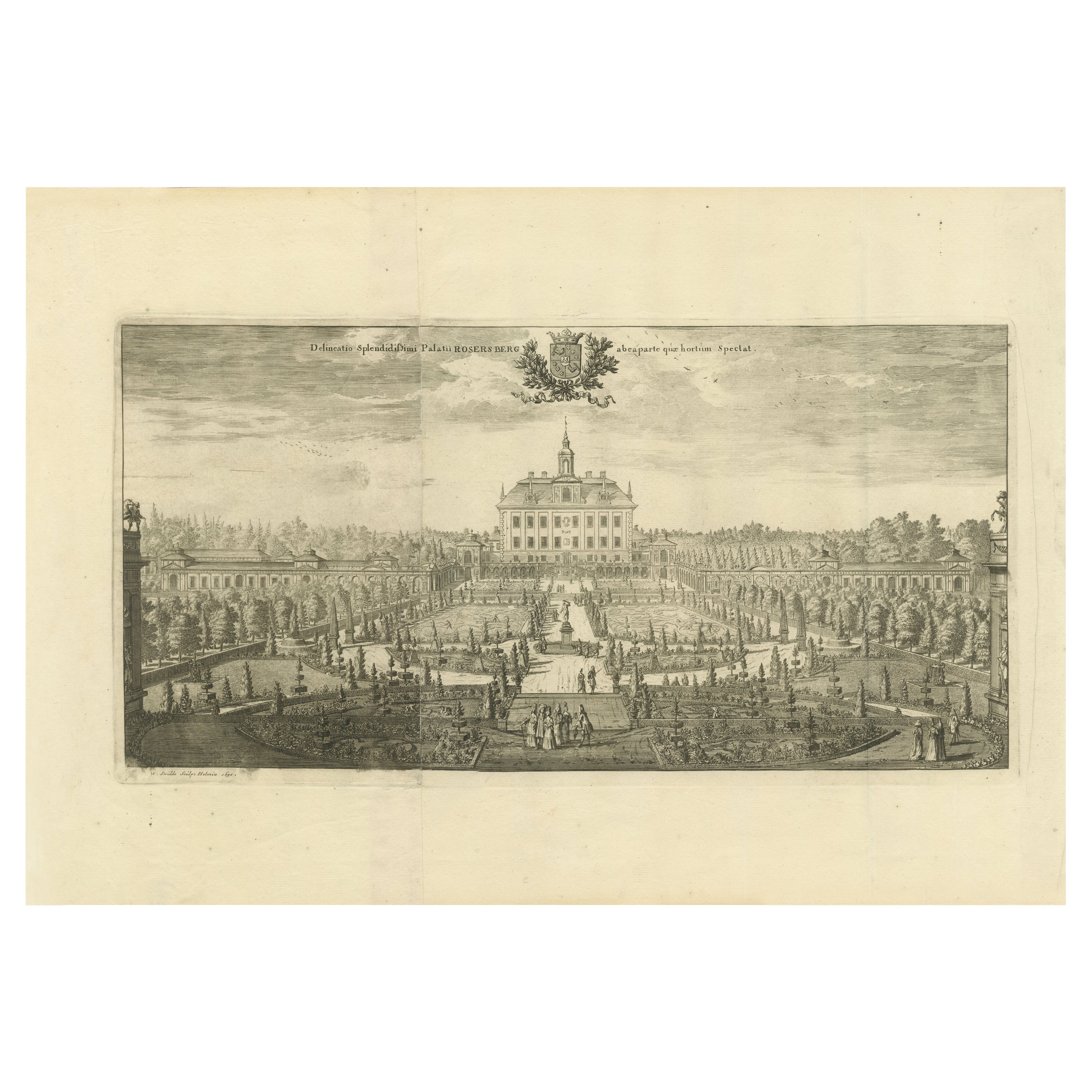Items Similar to The Southern Courthouse of Stockholm: An Engraving by Willem Swidde, 1691
Want more images or videos?
Request additional images or videos from the seller
1 of 9
The Southern Courthouse of Stockholm: An Engraving by Willem Swidde, 1691
About the Item
Title: "Cüria in Suburbio Australi Holmiae" - The Southern Courthouse, Now Stockholm City Museum
Description: This historical print, titled "Cüria in Suburbio Australi Holmiae," illustrates the Southern Courthouse of Stockholm, which today houses the Stockholm City Museum. Created in 1691 by the artist Willem Swidde, this copperplate engraving is a part of the renowned work "Suecia Antiqua et Hodierna."
The scene captures the courthouse in intricate detail, reflecting the architectural style of the era. The foreground is alive with the hustle and bustle of 17th-century city life, depicting citizens in period attire. Carriages and pedestrians enliven the cobblestone streets, while the grandeur of the courthouse stands as a testament to the civic pride of Stockholm.
You can also see construction work in Stockholm in 1691; likely the first time the Mursmäckas are depicted. Mursmäcka, also called bruksmäcka or only smäcka, was an historical profession for women in Sweden. A mursmäcka was a female construction worker with the task of handing mortar during construction work. The profession is recorded from at least 1691 (though it is not confirmed by name until the 1830s) and discontinued in 1922. This was a very hard but common job for a poor uneducated woman during the 19th century, particularly in Stockholm. In July 1888, the Mursmäcka of Stockholm performed a great strike action which attracted considerable attention in contemporary Sweden. The newspapers called it The Women's Strike. The last mursmäcka retired in 1922.
Swidde's work is characterized by a high degree of precision and clarity, traits that are evident in the fine lines and careful rendering of this print. The courthouse is portrayed with a balanced symmetry, and each window, column, and ornamental feature is meticulously depicted.
As part of "Suecia Antiqua et Hodierna," this print contributes to the grand vision of Sweden during its time as a great power, offering a view not just of the structures, but also of the social dynamics of the age. This piece holds significance both as a work of art and as a historical document, providing insight into the urban development and cultural heritage of Stockholm. For collectors and historians alike, it offers a window into the past and the enduring legacy of Swedish architecture and society.
Willem Swidde's contributions to the world of engraving, particularly in the context of "Suecia Antiqua et Hodierna," mark him as a significant figure in the field of cartography and illustration during the late 17th century. His move from Amsterdam to Stockholm represents the cross-cultural exchange of artistic skills that was quite common during this period, particularly in the context of grand projects that aimed to document and celebrate national achievements.
Swidde's involvement with "Suecia Antiqua et Hodierna" was a major undertaking, and the fact that he engraved 76 of its plates speaks to his skill and the trust placed in him by Erik Dahlbergh. The work they produced together not only served to glorify Sweden but also to create a lasting visual record of the country's landscapes, buildings, and historical moments. Swidde's artistry ensured that these engravings were not mere reproductions of Dahlbergh's drawings but were enhanced and refined in a collaborative process.
The history of Charles X Gustav of Sweden, "De Rebus a Carlo Gustavo Sveciae Regis," also benefited from Swidde's engraving talent, with 18 plates attributed to him. This work by Samuel Pufendorf would have been an important historical document for Sweden, and Swidde's engravings contributed significantly to its visual impact.
Swidde's premature death in Stockholm cut short a promising career. Despite the lack of extensive documentation on his life, his legacy lives on through the plates he produced, which continue to be appreciated for their beauty and precision. The prints from "Suecia Antiqua et Hodierna" remain valuable for their historical and artistic merit, and they provide a fascinating glimpse into the Sweden of the past as seen through the eyes of a talented Dutch engraver who made Stockholm his home.
- Dimensions:Height: 13.55 in (34.4 cm)Width: 17.72 in (45 cm)Depth: 0 in (0.02 mm)
- Materials and Techniques:Paper,Engraved
- Period:Late 17th Century
- Date of Manufacture:1691
- Condition:Very good, almost excellent. Visible plate mark. Very good antique condition with one -hardly visible- crease in left top outside the image. Later hand-coloring.
- Seller Location:Langweer, NL
- Reference Number:
About the Seller
5.0
Platinum Seller
These expertly vetted sellers are 1stDibs' most experienced sellers and are rated highest by our customers.
Established in 2009
1stDibs seller since 2017
1,928 sales on 1stDibs
Typical response time: <1 hour
- ShippingRetrieving quote...Ships From: Langweer, Netherlands
- Return PolicyA return for this item may be initiated within 14 days of delivery.
More From This SellerView All
- Banking on Prosperity: Södra Bancohuset of Stockholm in a 1691 Swidde EngravingLocated in Langweer, NLThis original antique image is a historical depiction from "Suecia Antiqua et Hodierna," which translates to "Ancient and Modern Sweden." This was a significant work of the mid-17th ...Category
Antique Late 17th Century Prints
MaterialsPaper
- Rosersberg Palace in Sweden: Dual Perspectives by Willem Swidde, circa 1695Located in Langweer, NLTitle: "Rosersberg Palace: Dual Perspectives by Willem Swidde" Description: The featured antique engravings portray Rosersberg Palace in Sweden, captured from two distinct vantage p...Category
Antique Late 17th Century Prints
MaterialsPaper
- Baroque Grandeur: The Rosersberg Palace Gardens in Swidde's 1695 EngravingLocated in Langweer, NLThe image is an original antique copperplate engraving by Swidde, completed in 1695. The scene is a meticulous depiction of an elegant palace and its formal gardens, rendered in the ...Category
Antique 1690s Prints
MaterialsPaper
- Baroque Splendor: The Östanå Manor in Gränna, 1692 Swidde EngravingLocated in Langweer, NLAn original copper engraving from the renowned "Suecia Antiqua et Hodierna," an atlas of Sweden created under the direction of Erik Dahlberg in the late 17th century. This particular engraving, crafted by Willem Swidde in 1692, depicts the Östanå herrgård (manor house) in Gränna, located in the Jönköping county of Småland. The engraving showcases the manor in a stately fashion, with a classical architectural design featuring symmetrical wings and a central structure adorned with a grand staircase. The scene is animated with figures in the foreground, indicating the manor's role as a hub of activity and societal life. The garden layout...Category
Antique Late 17th Century Prints
MaterialsPaper
- Baroque Opulence: The Eastern View of SIQVO Palace in Swidde's 1696 EngravingLocated in Langweer, NLAn engraving by Willem Swidde from 1696. The print features a palatial estate surrounded by formal gardens, a common representation of baroque architecture and landscaping. The centr...Category
Antique 1690s Prints
MaterialsPaper
- The Ekolsund Castle and Gardens in Sweden in Swidde's 1695 EngravingLocated in Langweer, NLThe print is aan original detailed 1695 engraving of Ekolsund Castle in Sweden, crafted by Willem Swidde. The engraving is part of the collection from "Suecia Antiqua et Hodierna," which was a grand work showcasing the estates and landmarks of Sweden through elaborate illustrations. The scene depicted in the engraving is a classic example of the baroque garden architecture style, with geometrically arranged gardens, symmetrical layouts, and an expansive approach leading up to the castle, emphasizing the grandeur and formality of the estate. The meticulous detail in the gardens and the inclusion of figures within the grounds suggest a vibrant and cultured estate life. Ekolsund Castle, located in Enköping Municipality in Uppsala County, Sweden, is a manor house with a rich history dating back to the 14th century. By the 15th century, it was owned by the prominent Bengt Jönsson...Category
Antique 1690s Prints
MaterialsPaper
You May Also Like
- French Large Engraving of an Eagle by SavignyLocated in Downingtown, PAFrom the description de l'Egypte. J. Ces. Savigny, 1809-1813. The stipple engraving depicts the Imperial Eagle. This is Aquila heliaca or the Easte...Category
Antique Early 19th Century French Regency Prints
MaterialsPaper
- Antique Copper Engraving of an Officer of Pikeman by Francis GroseBy Francis GroseLocated in New York, NYFrancis Grose entered the army early in life and served in the cavalry, infantry, and militia.He had a profound knowledge of antiquities and spent the greater part of his life collec...Category
Antique 19th Century English Renaissance Revival Prints
MaterialsPaper
- “The Restaurant of the House of Representatives” Engraving by Harper's WeeklyLocated in Colorado Springs, COThis original wood engraving is titled “The Restaurant of the House of Representatives, Washington, DC.” It was published as a double-page image, in the August 12, 1893 issue of the famous 19th century newspaper Harper’s Weekly. The print was illustrated by Charles Stanley Reinhardt. The House Restaurant, a unique part of life in the Capitol, has been in the same location since the 1857 Capitol Expansion. Congressional members’ busy work schedule made the availability of food on site a necessity. But the restaurant also served as an informal meeting spot for members to continue conversations and deal making. This 1893 print illustrates the convivial atmosphere. Details including elegantly dressed tables...Category
Antique 1890s American Prints
MaterialsPaper
- "the Man and the Big Blonde" by Willem de KooningBy Willem de KooningLocated in New York, NYThe Man and the Big Blonde is an original lithograph in colors on wove paper by Dutch-American artist Willem de Kooning,1982. Signed in print. Condition re...Category
Antique 1880s American Prints
MaterialsGold Leaf
- The Letter N an Engraving by Luigi Vanvitelli for King Carlos III, Italy, 1771By VanvitelliLocated in West Palm Beach, FLThe letter "N" engraved by L. Vanvitelli on laid paper in 1771. They were commissioned by King Carlos III of Italy as part of a historical series. It h...Category
Antique 1770s Italian Neoclassical Prints
MaterialsWood, Paper
- French Engraving of an Eagle from the Description de l'Egypte, J. Ces. SavignyBy C. de SavignyLocated in Downingtown, PAFrench Engraving of the Eastern Imperial Eagle from the Description de l'Egypte. J. Ces. Savigny, 1809-1813. The large stipple engraving depic...Category
Antique Early 19th Century French Neoclassical Prints
MaterialsPaper





